#inchmahome priory
Text
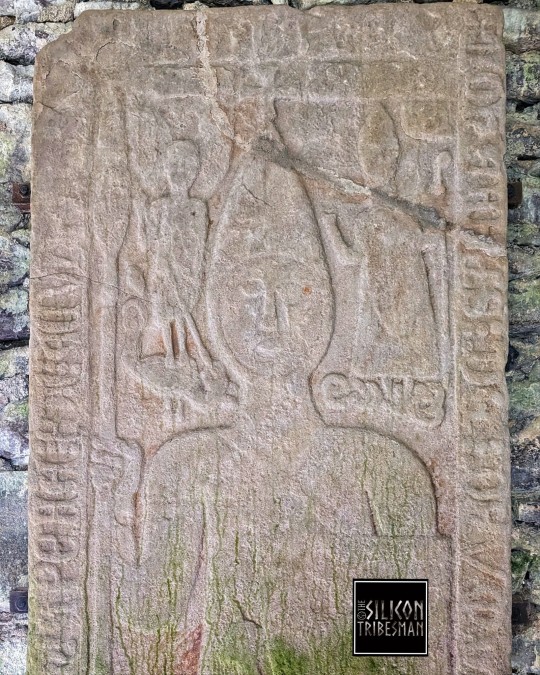
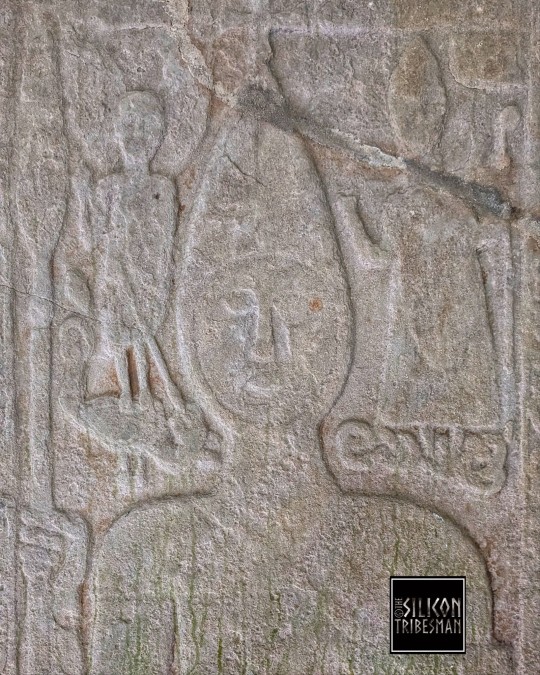

Inchmahome Priory Carved Stones, Inchmahome Priory, Lake of Menteith, Scotland
#stone carving#stonework#inchmahome Priory#Menteith#island#early religion#medieval#early belief#archaeology#design#noble#depiction#armour#knight#Scotland
56 notes
·
View notes
Text
The Four Mary's Linlithgow.
On way to Edinburgh so here's a wee bit history for you all while I sit on the bus.
The inside of the Pub is like a museum with lots of historical artefacts, don't expect to see the footie though, it doesn't have a television.
Some of you may know the song of the same name, which has been covered by many artists including The Corries, Joan Baez and Steelye Span, but the story behind the song dates back to the 16th century and centres on Mary Queen of Scots.
The Four Marys pub was named after the four ladies in waiting to Mary, Queen of Scots, who was born over the road in Linlithgow Palace.
They were Mary Seton, Mary Beaton, Mary Fleming and Mary Livingston. Mary Fleming was also a relative of Mary Queen of Scots, as Fleming’s mother was the illegitimate half-sister of Mary Queen of Scots’ late father King James V. The other ladies were of noble and high birth.
Although Mary Queen of Scots’ connection to France started at a young age, it wasn’t always certain that France would become her home. King Henry VIII first attempted to marry his son Prince Edward to the young Scottish Queen. Although some of the Queen of Scots’ nobles supported an English alliance, Marie de Guise and other nobles pushed for the Auld Alliance.
In 1548, the four Marys joined their Queen at Inchmahome Priory in preparation for their journey to France. The journey to France from Scotland was a rough sea voyage. It is recorded that during the journey, all of the ladies came down with sea sickness.
Upon their arrival in France, the station of Mary Queen of Scots and that of her ladies-in-waiting could not have been made clearer, as Mary was to join the Valois royal children whilst her ladies were initially separated from her. This could appear as a cruel move by the French King Henri II, however it was for the young Scottish Queen’s benefit. First of all, if she were to marry the Dauphin, she would need to learn to speak French and be associate with the Valois Princesses, Elisabeth and Claude. Secondly, by making her closest companions Henri’s daughters he could secure her loyalty and ensure she was surrounded by women of noble birth and of respectable character.
The four Marys were initially sent away to be educated by Dominican nuns. However their time in France was not to be for as long as anticipated, as although Mary Queen of Scots married Francis, they ruled France together for only a year before the young King died in 1560.
By this time, Marie de Guise, who had once decided her daughter’s future in France whilst protecting her realm in Scotland, had died. This left Mary no choice but to return to her country as queen. The four Marys returned with her to Scotland. Scotland would be the place where the four Marys would seek their own husbands, as their now widowed Queen would also seek out another.
Mary Queen of Scots married her cousin Lord Darnley in 1565. Her ladies also married, all except Mary Seton who remained in the Queen’s service until 1585 when she left the Queen’s household to join the house of God and become a nun. Mary Beaton married Alexander Ogilvy in April 1566.
Mary Beaton had a son James with her husband in 1568. Two years earlier, she had been there to support Mary Queen of Scots as she gave birth to her son and heir James, who would become James VI of Scotland and eventually, James I of England.
Mary Beaton lived a long life, dying at the age of fifty-five in 1598. Mary Beaton has been depicted in history as a model lady in waiting and one who was well educated. It is recorded that Mary Beaton’s own handwriting was very similar to that of Mary Queen of Scots.
Mary Livingston married her husband John Sempill in the same year that Mary Queen of Scots married Lord Darnley. Both Mary Livingston and her husband’s characters were not considered to be honourable and respectful, unlike those of her ladies Seton and Beaton. The Scottish Reformer John Knox wrote that Livingston was “lusty” and her husband was a “dancer”. He even rumoured that Livingston had conceived her child before the marriage and therefore was of unworthy character to be a lady-in-waiting to the Queen. These remarks by Knox were ignored by Mary Queen of Scots who granted wealth and land to her lady and her husband. Mary Livingston was even awarded some of the Queen of Scots’ jewels in her will. However she and her husband were ordered some years later to return them to the crown. Her husband John Sempill was arrested for refusing to return them. Livingston died in 1579.
Mary Fleming married a man who was many years older than her, Sir William Maitland. Maitland was the Queen’s royal secretary. There were rumours that their marriage was an unhappy one, but this has been largely disregarded by history and evidence proves otherwise. Their marriage took place after three years of courtship and therefore, they had time to get to know one another well before the marriage. In 1573 they were captured at Edinburgh Castle. Mary’s husband died shortly after their capture and she herself was kept a prisoner. Mary Fleming was forced to give up her belongings and her estate was not returned to her until 1581/2 by the then King James VI, the son of her former Queen and mistress.
There is a dispute over whether Fleming remarried but it is commonly believed that she did not. She had two children, James and Margaret. In 1581 the Queen of Scots tried to set up a meeting with Mary Fleming, but there is no evidence that this ever took place. Fleming died that same year.
The lives of the ladies-in-waiting of Mary Queen of Scots were very different, despite their common experiences and Dominican education in France; three married and only one lady actually returned to a life in a nunnery.

24 notes
·
View notes
Text

Inchmahome Priory, Lake of Menteith, Scotland. Daniel Gwerzman, April 2018
2 notes
·
View notes
Text
2nd January 1264: Marriage and Murder in Mediaeval Menteith
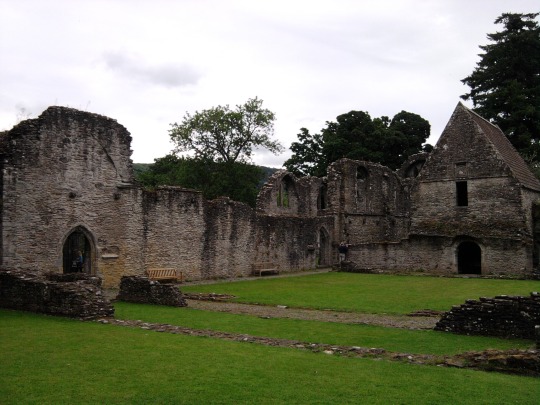
(Priory of Inchmahome, founded on one of the islands of Lake of Menteith in the thirteenth century)
On 2nd January 1264, Pope Urban IV despatched a letter to the bishops of St Andrews and Aberdeen, and the Abbot of Dunfermline, commanding them to enquire into a succession dispute in the earldom of Menteith. Situated in the heart of Scotland, this earldom stretched from the graceful mountains and glens of the Trossachs, to the boggy carseland west of Stirling and the low-lying Vale of Menteith between Callander and Dunblane. The earls and countesses of Menteith were members of the highest rank of the nobility, ruling the area from strongholds such as Doune Castle, Inch Talla, and Kilbryde. Perhaps the best-known relic of the mediaeval earldom is the beautiful, ruined Priory of Inchmahome, which was established on an island in Lake of Menteith by Earl Walter Comyn in 1238. Walter Comyn was a powerful, if controversial, figure during the reigns of Kings Alexander II and Alexander III. He controlled the earldom for several decades after his marriage to its Countess, Isabella of Menteith, but following Walter’s death in 1258 his widow was beset on all sides by powerful enemies. These enemies even went so far as to capture Isabella and accuse her of poisoning her husband. The story of this unfortunate countess offers a rare glimpse into the position of great heiresses in High Mediaeval Scotland, revealing the darker side of thirteenth century politics.
Alexander II and Alexander III are generally remembered as powerful monarchs who oversaw the expansion and consolidation of the Scottish realm. During their reigns, dynastic rivals like the MacWilliams were crushed, regions such as Galloway and the Western Isles formally acknowledged Scottish overlordship, and the Scottish Crown held its own in diplomacy and disputes with neighbouring rulers in Norway and England. Both kings furthered their aims by promoting powerful nobles in strategic areas, but it was also vital to harness the ambition and aggression of these men productively. In the absence of an adult monarch, unchecked magnate rivalry risked destabilising the realm, as in the years between 1249 and 1262, when Alexander III was underage.
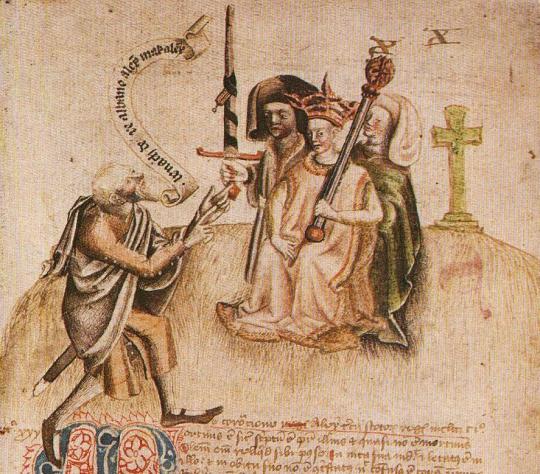
(A fifteenth century depiction of the coronation of Alexander III. Source: Wikimedia Commons)
Walter Comyn offers a typical picture of the ambitious Scottish magnate. Ultimately loyal to the Crown, his family loyalties and personal aims nonetheless made him a divisive figure. A member of the powerful Comyn kindred, he had received the lordship of Badenoch in the Central Highlands by 1229, probably because of his family’s opposition to the MacWilliams. In early 1231, he was granted the hand of a rich heiress, Isabella of Menteith. In the end, there would be no Comyn dynasty in Menteith: Walter and Isabella had a son named Henry, mentioned in a charter c.1250, but he likely predeceased his father. Nevertheless, Walter Comyn carved out a career at the centre of Scottish politics and besides witnessing many royal charters, he acted as the king’s lieutenant in Galloway in 1235 and became embroiled in the scandalous Bisset affair of 1242.
When Alexander II died in 1249, Walter and the other Comyns sought power during the minority of the boy king Alexander III. They were opposed by the similarly ambitious Alan Durward and in time Henry III of England, the attentive father of Alexander III’s wife Margaret, was also dragged into the squabble as both sides solicited his support in order to undermine their opponents. Possession of the young king’s person offered a swift route to power, and, although nobody challenged Alexander III’s right to the throne, some took drastic measures to seize control of government. Walter Comyn and his allies managed this twice, the second time by kidnapping the young king at Kinross in 1257. They were later forced to make concessions to enemies like Durward but, with Henry III increasingly distracted by the deteriorating political situation in England, the Comyns held onto power for the rest of the minority. However Walter only enjoyed his victory for a short while: by the end of 1258, the Earl of Menteith was dead.
Walter Comyn had dominated Scottish politics for a decade, and even if, as Michael Brown suggests, his death gave the political community some breathing space, this also left Menteith without a lord. As a widow, Countess Isabella theoretically gained more personal freedom, but mediaeval realpolitik was not always consistent with legal ideals. In thirteenth century Scotland, the increased wealth of widows made them vulnerable in new ways (not least to abduction) and, although primogeniture and the indivisibility of earldoms were promoted, in reality these ideals were often subordinated to the Crown’s need to reward its supporters. Isabella of Menteith was soon to find that her position had become very precarious.

At first, things went well. Although one source claims that many noblemen sought her hand, Isabella made her own choice, marrying an English knight named John Russell. Sir John’s background is obscure but, despite assertions that he was low born, he had connections at the English court. Isabella and John obtained royal consent for their marriage c.1260, and the happy couple also took crusading vows soon afterwards.
But whatever his wife thought, in the eyes of the Scottish nobility John Russell cut a much less impressive figure than Walter Comyn. The couple had not been married long before a powerful coterie of nobles descended on Menteith like hoodie-crows. Pope Urban’s list of persecutors includes the earls of Buchan, Fife, Mar, and Strathearn, Alan Durward, Hugh of Abernethy, Reginald le Cheyne, Hugh de Berkeley, David de Graham, and many others. But the ringleader was John ‘the Red’ Comyn, the nephew of Isabella of Menteith’s deceased husband Walter, who had already succeeded to the lordship of Badenoch. Even though Menteith belonged to Isabella in her own right, Comyn coveted his late uncle’s title there. Supported by the other lords, he captured and imprisoned the countess and John Russell, and justified this bold assault by claiming that the newlyweds had conspired together to poison Earl Walter. It is unclear what proof, if any, John Comyn supplied to back up his claim, but the couple were unable to disprove it. They were forced to surrender all claims to Isabella’s dowry, as well as many of her own lands and rents. A surviving charter shows that Hugh de Abernethy was granted property around Aberfoyle about 1260, but it seems that the lion’s share of the spoils went to the Red Comyn, who secured for himself and his heirs the promise of the earldom of Menteith itself.
Isabella and her husband were only released when they promised to pass into exile until they could clear their names before seven peers of the realm. John Russell’s brother Robert was delivered to Comyn as security for their full resignation of the earldom. Having ‘incurred heavy losses and expenses’, which certainly stymied their crusading plans, they fled.
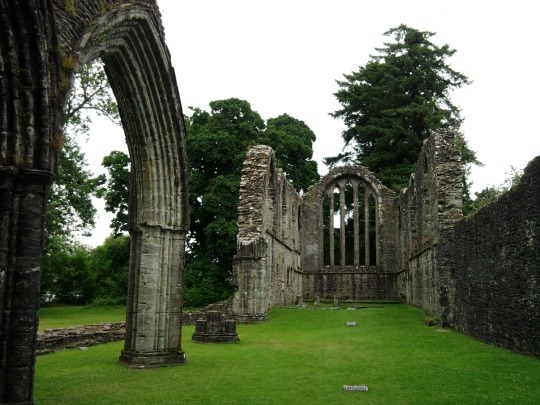
In a letter of 1264, Pope Urban IV described the couple as ‘undefended by the authority of the king, while as yet a minor’. However, though Alexander III was technically underage in 1260, he was now nineteen and could not be ignored entirely. Michael Brown suggests that Isabella and her husband may have been seized when the king was visiting England, and that John Comyn’s unsanctioned bid for the earldom of Menteith may explain why Alexander cut short his stay in November 1260 and hastily returned north, leaving his pregnant queen with her parents at Windsor. Certainly, Comyn was forced to relinquish the earldom before 17th April 1261. But instead of restoring Menteith to its exiled countess, Alexander settled the earldom on another rising star: Walter ‘Bailloch’ Stewart, whose wife Mary had a claim to Menteith.
Mary of Menteith is often described as Isabella’s younger sister, although contemporary sources never say so and some historians argue that they were cousins. Either way, Alexander’s decision to uphold her claim was probably as much influenced by her husband’s identity as her alleged birth right. Like Walter Comyn, Walter Bailloch (‘freckled’), belonged to an influential family as the brother of Alexander, Steward of Scotland. From their origins in the royal household, the Stewarts became major regional magnates, assisting royal expansion in the west. The promising son of a powerful family, Walter Bailloch was sheriff of Ayr by 1264 and likely fought in the Battle of Largs in 1263. In 1260 Alexander III had the opportunity to secure Walter’s loyalty as the royal minority drew to a close. Conversely John Comyn of Badenoch found himself out of favour and was removed as justiciar of Galloway following the Menteith incident. The king would not alienate the Comyns permanently, but for now, the stars of Walter Bailloch and Mary of Menteith were in the ascendant.

(Loch Lubnaig, in the Trossachs, another former possession of the earls of Menteith)
Isabella of Menteith and John Russell had not been idle in the meantime. Travelling to John’s home country of England, they probably appealed to Henry III. In September 1261, the English king inspected documents relating to a previous dispute over the earldom of Menteith. On that occasion, two brothers, both named Maurice, had their differences settled before the future Alexander II at Edinburgh in 1213. The elder Maurice, who held the title Earl of Menteith and was presumed illegitimate by later writers (though this is never stated), resigned the earldom, which was regranted to Maurice junior. In return the elder Maurice received some towns and lands to be held for his lifetime only, and the younger Maurice promised to provide for the marriage of his older brother’s daughters.
It is probable that Isabella was the daughter of the younger Maurice, and that she produced these charters as proof of her right to the earldom. Perhaps Mary was her younger sister, but it seems likelier that Isabella would have wanted to prove the younger Maurice’s right if Mary was a descendant of the elder brother, and therefore her cousin. However despite Henry III’s formal recognition of the settlement, he did not provide Isabella with any real assistance: for whatever reason, the English king was either unable or unwilling to press his son-in-law the King of Scots on this matter. Isabella then turned instead to the spiritual leader of western Europe- Pope Urban IV.

(A depiction of the coronation of Henry III of England, though in fact the English king was only a child when he was crowned. Source: Wikimedia Commons)
A long epistle which the pope sent to several Scottish prelates in January 1264 has survived, revealing much about the case. Thus we learn that Urban was initially moved by Isabella and her husband’s predicament, perhaps especially so since they had taken the cross. Accordingly, he had appointed his chaplain Pontius Nicholas to enquire further and discreetly arrange the couple’s restoration. Pontius was to journey to Menteith, ‘if he could safely do so, otherwise to pass personally to parts adjacent to the said kingdom, and to summon those who should be summoned’. But Pontius’ mission only hindered Isabella’s suit. According to Gesta Annalia I, the papal chaplain got no closer to Scotland than York. From there he summoned many Scottish churchmen and nobles to appear before him, and even the King of Scots himself. This merely antagonised Alexander III and his subjects. Although Alexander maintained good relations with England and the papacy throughout his reign, he had a strong sense of his own prerogative and did not appreciate being summoned to answer for his actions, especially not outwith his realm and least of all in York. Special daughter of the papacy or not, Scotland’s clergy and nobility supported their king and refused to compear. Faced with this intransigence, Pontius Nicholas placed the entire kingdom under interdict, at which point Alexander retaliated by writing directly to the chaplain’s boss, demanding Pontius’ dismissal from the case.
Urban IV swiftly backpedalled. In a conciliatory tone he claimed that Pontius was guilty of ‘exceeding the terms of our mandate’ and causing ‘grievous scandal’. To remedy the situation, and avoid endangering souls, the pope discharged his responsibility over the case to the bishops of St Andrews and Aberdeen, and the Abbot of Dunfermline. Thus the pope washed his hands of a troublesome case, the Scottish king’s nose could be put back in joint, and Isabella’s suit was transferred to men with great experience of Scottish affairs, who should have been capable of satisfactorily resolving the matter. However, there is no indication that Isabella was ever compensated for the loss of her inheritance, and when the dispute over Menteith was raised again ten years later, the countess was not even mentioned (probably she had since died). Possibly her suit was discreetly buried after it was transferred to the Scottish clerics, a solution which, however frustrating for the exiled countess, would have been convenient for the great men whose responsibility it was to ensure justice was done.

(Doune Castle- the earliest parts of this famous stronghold probably date to the days of the thirteenth century earls of Menteith, although much of the work visible today dates from the late fourteenth and early fifteenth centuries)
The Comyns could not be dismissed so easily. Never resigned to losing Menteith, John Comyn of Badenoch claimed the earldom again c.1273, on behalf of his son William Comyn of Kirkintilloch. William had since married Isabella Russell, daughter of Isabella of Menteith by her second husband.* The 1273 suit was unsuccessful but William Comyn and Isabella Russell did not lose hope, and in 1282, William asked Edward I of England to intercede for them with the king of Scots. In 1285, with William’s father John Comyn long dead, Alexander III finally offered a compromise. Walter Bailloch, whose wife Mary may have died, was to keep half the earldom and he and his heirs would bear the title earl of Menteith. William Comyn and Isabella Russell received the other half in free barony, and this eventually passed to the offspring of Isabella’s second marriage to Sir Edward Hastings. Perhaps this could be seen as a posthumous victory for Isabella Russell’s late parents, but their descendants would never regain the whole earldom (except, controversially, when the younger Isabella’s two sons were each granted half after Edward I forfeited the current earl for supporting Robert Bruce).
Conversely, Walter Bailloch’s descendants remained at the forefront of Scottish politics. He and his wife Mary accompanied Alexander III’s daughter to Norway in 1281, and Walter was later a signatory to both the Turnberry Band and the Maid of Norway’s marriage negotiations. He also acted as a commissioner for Robert Bruce (grandfather to the future king) during the Great Cause. He had at least three children by Mary of Menteith and their sons took the surname Menteith rather than Stewart. The descendants of the eldest son, Alexander, held the earldom of Menteith until at least 1425. The younger son, John, became infamous as the much-maligned ‘Fause Menteith’ who betrayed William Wallace, although he later rose high in the service of King Robert I. Walter Bailloch himself died c.1294-5, and was buried next to his wife at the Priory of Inchmahome on Lake of Menteith, which Walter Comyn had founded over fifty years previously. The effigies of Walter Bailloch and Mary of Menteith can still be seen in the chapter house of the ruined priory: the worn faces are turned towards each other and each figure stretches out an arm to embrace their spouse in a lasting symbol of marital affection.
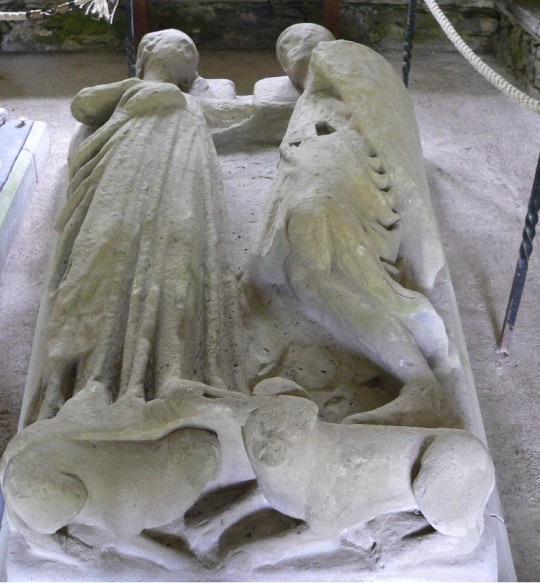
(The effigies of Walter Bailloch and Mary of Menteith at Inchmahome Priory, which was founded by Walter Comyn in 1238 and was perhaps intended as a burial site for himself and his wife Isabella of Menteith. Source: Wikimedia Commons).
The dispute over Menteith saw a prominent noblewoman publicly accused of murder and exiled, and even sparked an international incident when Scotland was placed under interdict. For all this, neither Isabella of Menteith nor John Comyn of Badenoch triumphed in the long term. Even Walter Bailloch eventually had to accept the loss of half the earldom after holding it for over twenty years. In the end the only real winner seems to have been the king. Although at first sight the persecution of Isabella and her husband looks like a classic example of overmighty magnates taking advantage of a breakdown in law and order during a royal minority, Alexander III was not a child and his rebuke of John Comyn did not result in any backlash against the Crown. Most of the Scottish nobility fell back in line once the king came of age, but the king in turn had to ensure that he was able to reward key supporters if he wanted to expand the realm he had inherited. Although it was important to both Alexander III and his father that primogeniture and were accepted by their subjects as the norm, in practice both kings found that they had to bend their own rules to ensure that the system worked to their own advantage. The thirteenth century is often seen an age of legal development and state-building, but these things sometimes came into conflict with each other, and even the most successful kings had to work within a messy system and consider the competing loyalties and customs of their subjects.
Selected Bibliography:
- “Vetera Monumenta Hibernorum et Scotorum”, Augustinus Theiner (a printed version of Urban IV’s original Latin epistle may be found here)
- “John of Fordun’s Chronicle of the Scottish Nation”, vol. 2, ed. W.F. Skene (this is an English translation of the chronicle of John of Fordun, made when Gesta Annalia I was still believed to be his work. It provides an independent thirteenth or fourteenth century Scottish account of the Menteith case
- “The Red Book of Menteith”, volumes 1+2, ed. Sir William Fraser
- “Calendar of Documents Relating to Scotland, Preserved Among the Public Records of England”, volumes 1, 2, 3 & 5, ed. Joseph Bain
- “The Political Role of Walter Comyn, earl of Menteith, during the Minority of Alexander III of Scotland”, A. Young, in the Scottish Historical Review, vol.57 no.164 part 2 (1978).
- “Scotland, England and France After the Loss of Normandy, 1204-1296″, M.A. Pollock
- “The Wars of Scotland, 1214-1371″, Michael Brown
As ever if anyone has a question about a specific detail or source, please let me know! I have a lot of notes for this post, so hopefully I should be able to help!
#Scottish history#Scotland#British history#thirteenth century#women in history#Menteith#earldom of Menteith#Isabella Countess of Menteith#John Russell#John Comyn I of Badenoch#Alexander III#Henry III#Pope Urban IV#Walter Bailloch#the Stewarts#House of Dunkeld#House of Canmore#Mary of Menteith#inchmahome priory
13 notes
·
View notes
Photo

2 notes
·
View notes
Photo

‘’Part effigy of an early 14th century knight, with the arms of Stewart on his shield, from Inchmahome Priory, Stirlingshire. Possibly commemorates Sir John Menteith, a descendant of the first Stewart Earls of Menteith. Broken off below knees. Hilt of sword and right forearm lost.’’
© Historic Environment Scotland
1 note
·
View note
Note
If you don't mind answering, what are some things that you really, really wish you'd see more of in depictions of medieval Scotland/Early Modern Scotland?
I absolutely don’t mind answering, thank you for asking!
I’m told there are some better quality novels than there are tv shows and films, so there are some aspects that have been done in good novels (though I’m not so familiar with them). There are so many things though that could be done on screen:
- Chiefly I spend a lot of my time wishing that there was more attention paid to the actual geographical make-up of Scotland and its regional variety, e.t.c beyond just splitting everything into Highland/Lowland, or just portraying everyone as being part of a Clan in the Highland sense, or just sticking everyone in Edinburgh as if that was the only place where anything happened. Orkney was very different to Galloway, and the Borders were very different to the Western Isles, and Ross was different to Aberdeenshire.
Now if this was true for the sixteenth century, it is even MORE true for the eleventh, twelfth, and thirteenth centuries. Between the early Middle Ages and the end of the thirteenth century, Scotland was settled by a lot of different cultures- so in the twelfth century for example, much of the country (the traditional heartland of ‘Scotia’ north of the Forth) may have spoken Gaelic but Lothian had been settled by speakers of Old English some centuries ago and their language became Scots in time, and spread north of the Forth into Fife, Angus, Aberdeenshire and elsewhere so that by the sixteenth century it was much more widely spoken and the language of government. The south-west, especially the area around the Clyde and Glasgow was a British kingdom for a long time, speaking a language not dissimilar to Old Welsh- this kingdom had (sort of) disappeared by the mid-twelfth century but the language took a while to completely disappear. Up in Orkney, Shetland, and Caithness, rather like in Iceland and the Faroes, Norse settlers had taken over and Norse culture has still left traces there today. From the fourteenth century, Scots began to take over in the Northern Isles but there was still a very clear Norse background in the sixteenth century. Meanwhile in the Western Isles, the Norse newcomers did not manage to erase Gaelic so completely as they did in the Northern Isles, but they did leave their mark on the Hebrides, to the extent that the inhabitants in the Western Isles in the in the twelfth century were descendants of both cultures- they are sometimes called Gall-Ghàidheil in Gaelic, meaning ‘foreigner Gael’. Then over the course of the twelfth century more new immigrants moved in. The ranks of the nobility were swelled by Norman, Breton, and other French settlers- unlike England, there was no ‘Norman Conquest’, and the process was more gradual, but although the French language never had the same power in Scotland as it did in thirteenth century England, these settlers left their mark on the feudal system and other aspects of Scottish society, and in turn they too were affected by the cultures they encountered in Scotland. Other smaller pockets of immigration existed- immigrants from Flanders and the Netherlands, for example, were instrumental to developing Scottish towns and improving agriculture. In the east coast burghs of Fife and Lothian you can still see some architectural elements that may have been the result of trade with the Dutch- crow-stepped gables and red pantiles for example.
Although most of these cultures have altered and changed by the sixteenth century, the fact remains that the cultural backdrop to fourteenth or fifteenth century Scotland was a real mix- Gaelic, English, French, Norse, Flemish, British- and, perhaps, whatever it was that the elusive Picts left behind beyond their wonderful stone monuments. I have perhaps oversimplified things here but the point is that mediaeval and early modern Scotland was not a cultural monolith- something which both Scottish and foreign film-makers would do well to remember.
There are also changes to these regions across the years- Orkney going from being a Norwegian/Danish territory to becoming part of the Scottish kingdom, or the borders which had some of the best farmland and richest abbeys in the country in the thirteenth century becoming a very militarised and rather lawless zone after the Wars of Independence. I think it would be really interesting to see that portrayed on screen.
- Ok so that was the fundamental thing, apologies for the rant. But to go with that, more understanding of the landscape and architecture. In all fairness most tv shows and films involving Scotland, no matter how bad they are, at least have some lovely panning shots of the Highlands but there’s more to the country than Glencoe- you could really work with views like the sun on the sea from the Carrick coast or the beautiful if ruinous religious architecture- like the abbeys of Melrose or Arbroath or somewhere like Elgin Cathedral or Rosslyn Chapel or Inchmahome Priory.
- Costuming! Again this fits into the regional thing a bit, but it’s also more general. It’s a quibble I have with almost any medieval media but especially when it comes to Scotland people get really lazy with the costuming and just slap some shortbread tin stuff together rather than putting any thought into it.
- More traditional music! A surprising number of ballads and songs that are still popular among folk singers today are thought to have their roots in early modern if not mediaeval Scotland. And again the musical heritage of Scotland is varied depending on the culture it comes from.
- More properly developed female characters. Even though half the historical films made about Scotland are about Mary Queen of Scots, there are almost no good depictions of historical Scotswomen- and that’s NOT because there aren’t any interesting women in Scottish history before the modern period! There are lots of fascinating women’s stories from mediaeval and early modern Scotland, and although we are often frustrated by a lack of sources, we know they were there. More importantly, even if every woman was not a Certified Bad-Ass, as a whole women in Scottish history are not invisible and we can often see them in the records, whether operating in domestic, business, religious, or political contexts. Oddly, in their quest to show how Uniquely Misogynistic and Evil the Scottish nobility were to Mary Queen of Scots or Margaret Tudor or whoever, film-makers often end up ignoring women’s stories and therefore perpetuating the sexist view of history they claim to hate. (Though, yes mediaeval and early modern Scotland WAS misogynistic- but show me a country that wasn’t. Also it was misogynistic in a slightly different way to some other countries). I could list off dozens of interesting Scotswomen who lived before 1603- even though we sometimes can’t tell that much about their inner lives from the surviving sources, it’s obvious they were of some importance. And again it fits back into the cultural variety thing, because that was not limited to Lowland, Scots-speaking noblewomen.
- More art and literature and architecture and education and music and EVERYTHING. Scotland lost a LOT during the Reformation and due to Anglo-Scottish warfare (that’s what happens when the main centre of your kingdom is near to a border). But we know that, though it was sometimes an out of the way place, Scotland could be just as heavily tied into European cultural trends as any other northern country. And there are some beautiful surviving cultural artefacts that hint at a more vibrant past- both produced in Scotland (in the Gaelic and Scots-speaking environments) and imported from abroad.
- Equally on that note, more focus on its connections to countries other than England. Scotland had three universities by 1500, and yet many Scottish students still went to study abroad, especially in France, but also in England, the Low Countries, Italy, and elsewhere. An Italian humanist taught at the Abbey of Kinloss away up in Moray in the sixteenth century, and Scottish thinkers were in touch with other great minds of the day. Scots also fought abroad (see mercenaries in Sweden, or James IV’s support given to his uncle the king of Denmark, or the Garde Écossaise), and traded heavily across the North Sea (there were multiple Scots merchant colonies on the continent, not least at Veere). Scotland’s relations with Norway, Denmark, the Low Countries, the Papacy, Ireland (both as part of the kingdom of England and with individual Irish families), and other countries could be almost as important as its relationships with France and England. The eternal triangle of Scotland, England, and France, was not actually always the story- there were occasions when England and France played very little role in Scotland’s foreign affairs, let alone its domestic history.
- In particular an acknowledgement of the high quality of Scots poetry in the late fifteenth and early sixteenth centuries wouldn’t go amiss.
- This is one which applies to all mediaeval media- but a more varied and interesting depiction of mediaeval religion would be good. In Scotland, this was also linked to the way people saw their own history- any sixteenth century Scot would have known some of the native saints, and anyone half-educated might have heard the names of David I and St Margaret and Columba, and known where the great abbeys in the kingdom came from.
- Actually a basic knowledge of Scottish history and legends beyond a few famous names. For example family was important in noble society- just because the stereotypical The Clans Are Gathering model is massively inaccurate, doesn’t mean that noble families in Scotland didn’t care about ancestry and kinship. But it would be great if tv shows and movies could actually think about how to portray that- and it really shows how little some of these scriptwriters know about their characters when they’re supposedly obsessed with the honour of the clan but the only piece of their country’s history they know is the name William Wallace. If you’re portraying the Douglases- even the earls of Angus who weren’t directly descended from him- the legacy of Sir James Douglas would have been a source of some pride. For actual ‘clans’, you could be dealing with some of the clans in the west of Scotland who, like some families in Ireland, claimed descent from Niall of the Nine Hostages. Some family histories got warped along the way- the Stewarts, for example, seem to have forgotten that they were descended from a Breton named Flaald by the fifteenth century and instead latched onto a story involving a character named Fleance (the one who later appears in Macbeth). As for legends- you could have a lot of fun with the different kinds of fairy belief that existed in Scotland, from the Borders (where it inspired ballads like Tam Lin) to the Highlands, or you could bring up legendary figures that are shared with other countries like King Arthur or Fionn Mac Cumhaill or Robin Hood or Hector of Troy. Sometimes the legends even cross over into real life- Thomas the Rhymer, hero of ballads and fairytales, seems to have been based on a real person who lived in the reign of Alexander III; while stories about William Wallace and Robert Bruce often became folk tales in the tradition of other greenwood outlaws like Robin Hood.
I think it’s pretty evident that my main issues with depictions of mediaeval and early modern Scotland on tv and film are largely because it’s so utterly unlike anything I see in the historical record. I’d love to list specific details and characters I’d like to see portrayed on screen, but before we even get to that point, the whole Generic Portrait of Scotland needs to change, because it doesn’t currently feel very realistic or interesting. All I really want is for the same level of research to be done with regard to Scotland as is done for England or France or any other country- England is often portrayed inaccurately, but there’s still at least 200% more effort put in than for Scotland.
On that note though, James I’s career (or at least the early fifteenth century as a whole) has been ripe for a television adaptation for years. Also I’m personally fascinated by ordinary rural life, patterns of agriculture and landholding, e.t.c. so even just an ordinary story set in an early sixteenth century fermtoun would be cool. But I don’t really think these stories would make any sense to people if Scotland was just portrayed the way it usually is - a generic country with no culture beyond a few scraps of tartan and alcohol and Anglophobia.
Thank you for the opportunity to rant, and apologies for the screed! I couldn’t express my enthusiasm very concisely I’m afraid. I genuinely don’t mind if there’s some inaccuracies to portrayals of Scotland, but now all portrayals are exactly the same and almost wholly inaccurate so it gets frustrating.
16 notes
·
View notes
Text
British Library digitised image from page 393 of "The Lake of Menteith: its islands and vicinity. With historical accounts of the Priory of Inchmahome and the Earldom of Menteith. ... Illustrated with pen and ink drawings by W. Bain"

Image taken from:
Title: "The Lake of Menteith: its islands and vicinity. With historical accounts of the Priory of Inchmahome and the Earldom of Menteith. ... Illustrated with pen and ink drawings by W. Bain"
Author(s): Hutchison, Andrew Fleming [person] ; Bain, Walter [person]
British Library shelfmark: "Digital Store 10369.i.20"
Page: 393 (scanned page number - not necessarily the actual page number in the publication)
Place of publication: Stirling (Scotland)
Date of publication: 1899
Publisher: E. Mackay
Type of resource: Monograph
Language(s): English
Physical description: xxxiv, 368 pages (8°)
Explore this item in the British Library’s catalogue:
001778009 (physical copy) and 014814096 (digitised copy)
(numbers are British Library identifiers)
Other links related to this image:
- View this image as a scanned publication on the British Library’s online viewer (you can download the image, selected pages or the whole book)
- Order a higher quality scanned version of this image from the British Library
Other links related to this publication:
- View all the illustrations found in this publication
- View all the illustrations in publications from the same year (1899)
- Download the Optical Character Recognised (OCR) derived text for this publication as JavaScript Object Notation (JSON)
- Explore and experiment with the British Library’s digital collections
The British Library community is able to flourish online thanks to freely available resources such as this.
You can help support our mission to continue making our collection accessible to everyone, for research, inspiration and enjoyment, by donating on the British Library supporter webpage here.
Thank you for supporting the British Library.
from BLPromptBot https://ift.tt/3hR66z0
0 notes
Photo

Inchmahome Priory is situated on Inchmahome ("Inch" meaning an island), the largest of three islands in the centre of Lake of Menteith, close to Aberfoyle, Scotland. The name "Inchmahome" comes from the Gaelic Innis MoCholmaig, meaning Island of St Colmaig. The priory was founded in 1238 by the Earl of Menteith, Walter Comyn, for a small community of the Augustinian order (the Black Canons). The Comyn family were one of the most powerful in Scotland at the time, and had an imposing country house on Inch Talla, one of the other islands on the Lake of Menteith. There is some evidence that there was a church on the island before the priory was established.
0 notes
Text
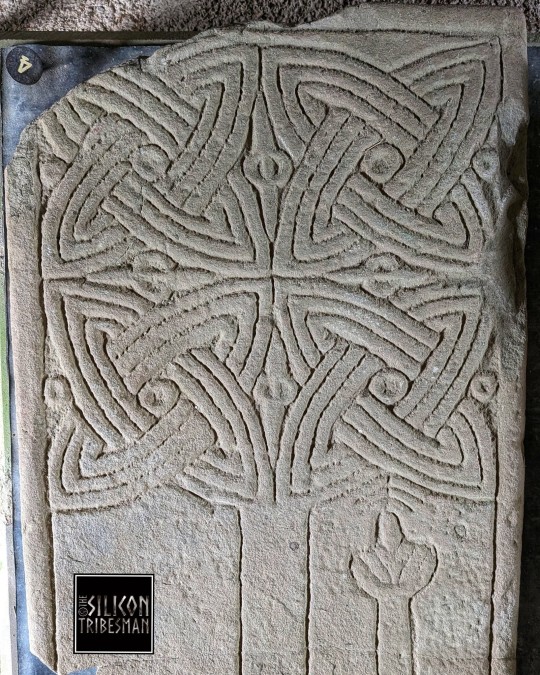
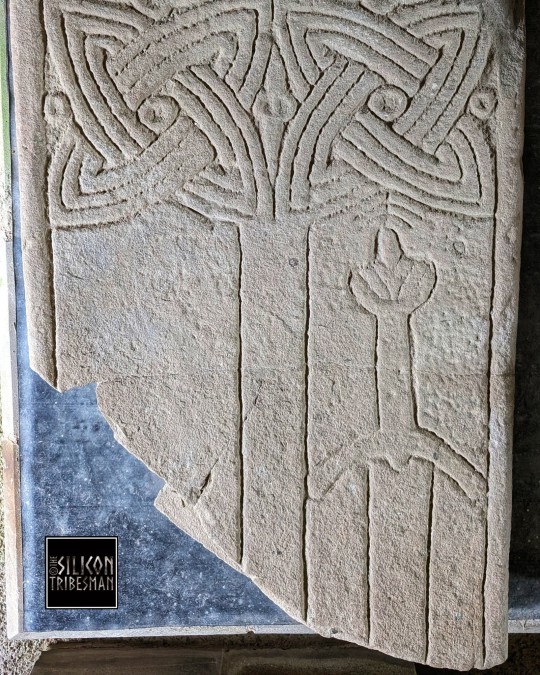
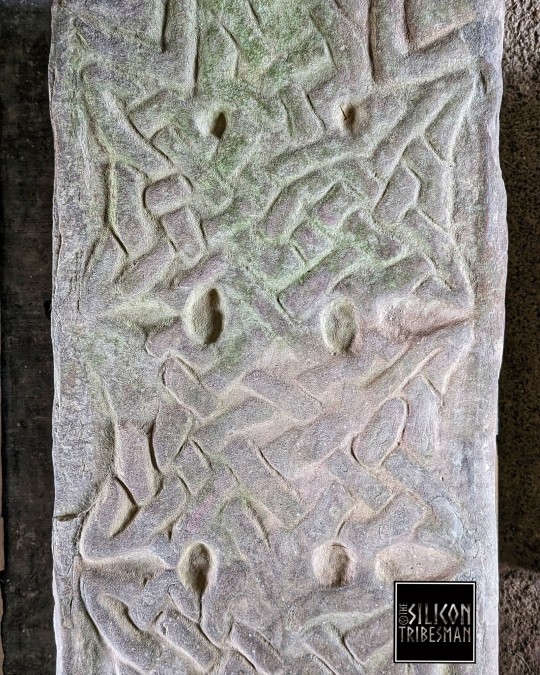


Inchmahome Priory Ancient Carved Stones, Inchmahome Priory, Lake of Menteith, Scotland
#ancient living#stonework#carved stone#stone#designs#design work#pattern#Scotland#Ancient Scotland#wild places#island
173 notes
·
View notes
Photo
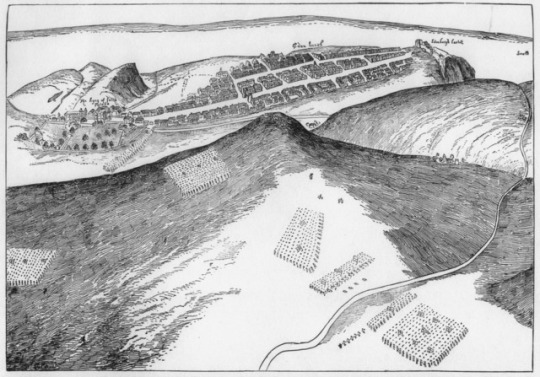
On 7th May 1544 the Earl of Hertford invaded Scotland.
Dates vary for this, wiki has May 3rd, the dates aren't important, this was a brutal invasion, the trail of destruction was considerable. Edinburgh, with the exception of the castle, was almost totally destroyed in May 1544. The prosperous towns of Musselburgh and Dunbar were similarly set ablaze by troops sent north by the aging Henry VIII.
Yet despite winning a decisive battle against the Scots at Pinkie Cleugh in 1547, and occupying several castles for prolonged periods, the English crown achieved little during the campaign other than spending considerable amounts of money and causing misery for the local populace.
The reason for this was Henry VIII wanted his son, Edward. The war became known as the 8, or 9 year war, years later it has become more well known as "The Rough Wooing"
To understand this further we have to look back to Mary's father James V the last great catholic king of Scots. He inherited the crown aged 17 months when his father, James IV, was killed at the battle of Flodden in 1513.
He dismissed his regents and assumed power in 1528. By then, the Protestant Reformation was already underway in continental Europe. Scotland was unaffected by this upheaval until 1533 when its closest neighbour and oldest rival, the kingdom of England, broke with Rome.
While Henry VIII shut down monasteries and seized church property, the old religion continued as normal north of the border. Initial relations between James and Henry were cordial. Henry’s sister, Margaret, was James’ mother. But relations soured as the 1530s wore on, with the two monarchs increasingly at loggerheads over religion. The Scots king’s refusal to meet his uncle in person at York ended any relationship between the two men.
War broke out between the two countries in 1542. An initial Scots victory in August at Haddon Rig was crushingly reversed in November on the border at Solway Moss. Although there were few soldiers killed, more than 1200 of James’ army were taken prisoner. James, already ill, died two weeks later at Falkland Palace. The crown passed to his baby daughter Mary, born just six days before. Scotland had yet another infant monarch, and another Regent ruling in place of her, James Hamilton, Earl of Arran.
It appeared a personal union between Scotland and England through the marriage of Mary and Edward was now inevitable. Henry was determined to impose his will on the weakened Scottish kingdom and permanently end its alliance with catholic France. A treaty signed at Greenwich in July 1543 agreed the infant Mary would marry Edward, Henry’s only son.
I like getting quotes from the day, and this is said to be the response to the proposed marriage from the noted Scottish lawyer and diplomat, Adam Otterburn, who had been Kings Advocate to the late James V and was secretary to Mary de Guise and Arran.
" Our people do not like of it. And though the Governor and some of the nobility have consented to it, yet I know that few or none of them do like of it; and our common people do utterly mislike of it. I pray you give me leave to ask you a question: if your lad was a lass, and our lass were a lad, would you then be so earnest in this matter? ... And lykewise I assure you that our nation will never agree to have an Englishman king of Scotland. And though the whole nobility of the realm would consent, yet our common people, and the stones in the street would rise and rebel against it."
Scotland’s nobility was divided between a pro-English protestant faction and catholics loyal to Mary of Guise, James’ widow. Regent Arran was initially a protestant, but dramatically switched sides after a meeting with Cardinal David Beaton. He agreed to a rival plan to send the Scots queen to France to marry the dauphin, Francis.The Scottish Parliament renounced the Treaty of Greenwich in December 1543.
A furious Henry declared war that same month. The Scots could scarcely have predicted the savagery that would follow. An English army, under the command of the Earl of Hertford, attacked Edinburgh. Contemporary accounts suggest every building in the capital, including Holyrood Abbey and the palace, was burnt. Only the castle held out against the invaders. English ships were filled with looted goods at Leith and sailed south. The English army retreated over land, burning villages as it went.
Meanwhile, pro-English agents were instructed to spread the word that the invasion was solely the fault of Cardinal Beaton, who was accused of leading Arran astray. The aim was to ferment anti-catholic feeling and bolster the protestant faction. The Scots gained some revenge the following year at the battle of Ancrum Moor. An army led by Arran routed an English force, which had been marauding in the Borders. An uneasy truce held for 18 months.
Henry VIII died in January 1547 and the teenage Edward VI ascended to the English throne. Edward’s uncle, the Duke of Somerset, became regent. He was keen to resume the campaign in Scotland and break its association with France, as well as capture the young Queen Mary.Arran was pre-warned about the English military build-up and told to expect invasion. Preparations to defend Edinburgh began. Somerset’s army, numbering around 17,000, could call upon the latest technology from across Europe, including muskets and modern artillery. His troops were further strengthened by battle-hardened Italian and German mercenaries. The Scots force, although numbering around 30,000, relied on much the same tactics used 30 years before at Flodden. The two sides met by the River Esk near Musselburgh on 10 September 1547, a day that would become known in Scotland as Black Saturday.
The battle of Pinkie Cleugh was a comprehensive victory for Somerset. A combination of superior weaponry, position and discipline made the difference. Scots casualties were estimated at 6,000-15,000.
Despite such a resounding defeat, the Scottish nobility, still led by Arran, refused to come to terms. Queen Mary, now aged four, was safely hidden at the island priory on Inchmahome while preparations were made for her escape to France. Somerset garrisoned troops across the east of Scotland and made his headquarters at Haddington, but could not break the political deadlock.
The Scots hardened their attitudes and refused to negotiate. As time passed, with no resolution in sight, the financial cost of the occupation became increasingly hard to justify. Meanwhile, Mary of Guise appealed for help from France and troops eventually arrived to fortify Leith and maintain resistance. The young queen was finally smuggled out of Scotland in August 1548 to France.
With Mary safely out of Somerset’s reach, and increased help from French troops, Arran’s position was secure. The English abandoned Haddington in September 1549. A peace treaty between France and England in March 1550 effectively ended the conflict. A formal peace was agreed with Scotland the following year.
The idea of the war as a ‘wooing’ was popularised by Sir Walter Scott. By the mid-19th century the term had began to appear in history books.The phrase ‘Rough Wooing’ is thought to derive from a remark attributed to George Gordon, Earl of Huntly by Patrick Abercromby. “We liked not the manner of the wooing, and we could not stoop to being bullied into love.”
Modern historians have noted the inappropriateness of such a jocular name to describe such a savage war.
The pic is a facsimile of a contemporary sketch showing the deployment of Hertford's forces before they burnt Edinburgh in May 1544
22 notes
·
View notes
Text




Inchmahome Priory, Lake of Menteith, nr Aberfoyle, Scotland
Godot13, August 2016 (Andrew Shiva / Wikipedia / CC BY-SA 4.0)
(left) Anna Krylova, October 2019
(right) Alex Mckendrick, June 2019
Daniel Gwerzman, April 2018
3 notes
·
View notes
Photo

Big old tree (at Inchmahome Priory) https://www.instagram.com/p/BwmvL9olt72/?utm_source=ig_tumblr_share&igshid=13r2595v29ba9
0 notes
Text
My Maternal 13th. Great Scottish Grandfather, Archibald Campbell, 4th. Earl of Argyll
My Maternal 13th. Great Scottish Grandfather, Archibald Campbell, 4th. Earl of Argyll
Archibald Campbell, 4th Earl of Argyll was the son of Colin Campbell, 3rd Earl of Argyll and Jean Gordon.
He married, firstly, Lady Helen Hamilton, daughter of James Hamilton, 1st Earl of Arran and Janet Bethune, after 27 August 1529.
He married, secondly, Lady Margaret Graham, daughter of William Graham, 3rd Earl of Menteith and Margaret Moubray, on 21 April 1541 at Priory of Inchmahome,…
View On WordPress
0 notes
Photo

Lake of mentieth #heartofscotland #beautiful #country #ig_scotland (presso Inchmahome Priory)
0 notes
